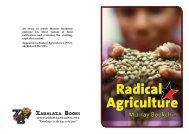smash-pacifism-zine
smash-pacifism-zine
smash-pacifism-zine
Create successful ePaper yourself
Turn your PDF publications into a flip-book with our unique Google optimized e-Paper software.
inflexible bastion of segregation—agreed to desegregate<br />
downtown stores, and President Kennedy backed the<br />
agreement... The next day, after local white supremacists<br />
bombed a black home and a black business, thousands of<br />
black people rioted again, seizing a 9 block area, destroying<br />
police cars, injuring several cops (including the chief<br />
inspector), and burning white businesses. A month and a<br />
day later, President Kennedy was calling for Congress to<br />
pass the Civil Rights Act, ending several years of strategy<br />
to stall the civil rights movement. Perhaps the largest of the<br />
limited, if not hollow, victories of the civil rights movement<br />
came when black people demonstrated they would not<br />
remain peaceful forever. Faced with the two alternatives,<br />
the white power structure chose to negotiate with the<br />
pacifists...”<br />
(How Nonviolence Protects the State, p. 12)<br />
Compare this account of the Birmingham<br />
campaign to that promoted by<br />
pacifists:<br />
“The Birmingham campaign<br />
got underway with a series of<br />
demonstrations and sit-ins in early<br />
April 1963. As the marches spread,<br />
hundreds were arrested, including<br />
King...<br />
“As the weeks passed and the<br />
number of arrested climbed<br />
(eventually surpassing 2,600), the<br />
campaign strategy seemed to be<br />
foundering. Connor [the police chief]<br />
had not yet been provoked into<br />
overreaction, and the numbers of<br />
people willing to face arrest began to dwindle. In a bold<br />
escalation of tactics, organizers called on school children to<br />
join the marches. Hundreds of students eagerly responded<br />
and, like other demonstrators, were promptly hauled off to<br />
jail... Their presence was the straw that broke the back of<br />
Connor's patience. On Friday, 3 May, as hundreds of<br />
students and other demonstrators approached Kelly Ingram<br />
Park near downtown, Connor unleashed police dogs and<br />
fire hoses, and a gruesome display of police brutality<br />
unfolded before television news cameras... This was a<br />
decisive turning point in the Birmingham campaign, and<br />
indeed the entire civil rights movement. It led quickly to a<br />
negotiated agreement in Birmingham and prompted the<br />
Kennedy administration to begin work on a national civil<br />
rights legislation...<br />
“The media strategy was a brilliant success locally<br />
and nationally. The images of disruption and mass protest<br />
contributed to the crisis atmosphere in the city...” (Gandhi<br />
and Beyond, pp. 141-43).<br />
Birmingham riot, May 1963.<br />
Nowhere is there any mention of the two nights of<br />
rioting, which significantly added to the disruption and<br />
“crisis atmosphere” in the city. This is a classic example of<br />
pacifist revision of history in order to promote their<br />
doctrine.<br />
While the boycott was undoubtedly successful in<br />
that it deprived racist white store owners of profits, the<br />
rioting did more than this—it destroyed substantial amounts<br />
of their property (the businesses themselves were targeted<br />
by rioters). It also threatened even greater escalations in<br />
violence, with an angry, hostile, militant resistance having<br />
now manifested itself.<br />
Yet, this is of no concern to the pacifists, precisely<br />
because it contradicts the belief that the Birmingham<br />
victory was entirely the result of nonviolent protest:<br />
“The Birmingham campaign was a dramatic<br />
victory, brought about by the heroic sacrifice of<br />
thousands of local citizens and by the development and<br />
implementation of wise strategy.”<br />
(Gandhi and Beyond, p. 144)<br />
Nor was the Birmingham<br />
rebellion the only manifestation of a<br />
new militancy:<br />
“Across America black<br />
fury had broken loose. A swirl of<br />
protests, touched off by weeks of<br />
racial strife in Birmingham,<br />
Alabama, now engulfed much of the<br />
country. Between May and late<br />
August of 1963, there had been<br />
1,340 demonstrations in over 200<br />
cities in thirty-six states. Some were<br />
communities long fractured along<br />
racial lines. Others had never before<br />
been touched by violence. In<br />
Cambridge, Maryland, a once-tranquil cannery town... the<br />
governor declared martial law in July after black rioters<br />
shot and wounded five whites, including two National<br />
Guardsmen...<br />
“But angry street protesters were not the only<br />
problem, Henderson [a black Justice Department employee]<br />
continued. The feeling among leading ministers was that<br />
'they should stop preaching nonviolence'...<br />
“In Chicago, blacks rioted through the south side in<br />
late May after a white police officer shot a fourteen year old<br />
black boy...<br />
“The violence was unrelenting and continued deep<br />
into the summer. The very randomness of the unrest made it<br />
all the more frightening. In August, protesters in<br />
Philadelphia... fought pitched battles with riot police. The<br />
violence was especially shocking because the<br />
demonstrations were sponsored by the NAACP,<br />
traditionally one of the more restrained national civil rights<br />
groups. 'My basic strength,' boasted Cecil Moore, the head<br />
of the organization's local chapter, 'is those 300,000 lowerclass<br />
guys who are ready to mob, rob, steal and kill.' For<br />
Moore, the strategy of nonviolent protest had run its<br />
course...” (The Bystander, pp.1-2).<br />
47



